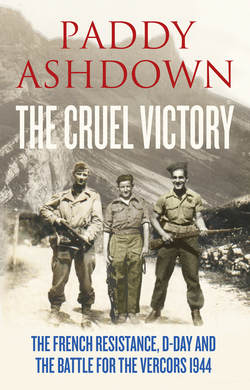Читать книгу The Cruel Victory: The French Resistance, D-Day and the Battle for the Vercors 1944 - Paddy Ashdown, Paddy Ashdown - Страница 25
14 MARCH 1944
ОглавлениеThe instructions given by Winston Churchill in February 1944 that arms drops to the Resistance should be doubled in the month of March produced swift results, most, but not all of them, welcome to the Vercors. On 4 March, in what seems a desperate measure to dispatch arms by any means, the RAF carried out a ‘blind drop’* of containers near Romans. Peter Ortiz, who was in the area at the time, complained bitterly to London in an ‘outspoken denunciation … As soon as he received the warning [of the drop] he left to try to stop the Germans recovering the material which had been dropped, but it was they who had the largest share. Such operations put the whole region into an excited state and expose the population to harsh reprisals as well as putting the reception committees to unjustifiable risks.’
On 10/11 March, the night of the March full moon, the first major parachute drop the plateau had received since Darbonouse four months previously took place when five Stirling heavy bombers successfully parachuted containers at a site codenamed Gabin, 2 kilometres west of Saint-Martin-en-Vercors, in an open valley surrounded by woods.
Five days later, at 01.05 hours on 16 March 1944, a Halifax bomber captained by Pilot Officer Caldwell took off from RAF Tempsford on Operation Bob 149. His mission was to drop eighteen containers packed with arms and seven packages to the Gabin site. Caldwell crossed the Channel and, skirting Paris, continued south over Burgundy and Bourg-en-Bresse to his final landmark, the Lac de Charavines, 60 kilometres north-west of his target. The lake was not difficult to spot, its silver surface shimmering like a mirror in the moonlight. Here Caldwell started his twenty-minute ‘dead reckoning’ run in to his target. His after-action report is brief: ‘Pinpointed lake WNW of Target & ground detail. Lights on when aircraft arrived’.
Judging from Caldwell’s description, he overflew the target from the north in order to establish its precise location and exchange code signals with the reception team: ‘Good reception and correct letter’. Banking his aircraft, he retraced his steps from the south, the moon now shining over his right shoulder. With the Gabin site visible, he reduced his height above the ground to a spine-tingling 120 metres. On his first run, he dropped nine containers and five packages before pulling out to avoid the high ground north of the Gorges de la Bourne, swinging the big Halifax round again and repeating the same procedure from the north to south, dispatching the remaining nine containers and two packages. Caldwell had arrived over Gabin at 04.02 hours and, twenty minutes later, his mission accomplished, he was heading home for Tempsford. He had an uneventful return journey, dropping leaflets over the little Burgundy town of Époisses, half hidden in the ‘ground haze over northern France’, and touching down at his home base a little before dawn at 07.10.
